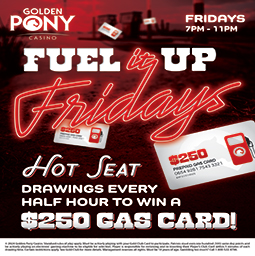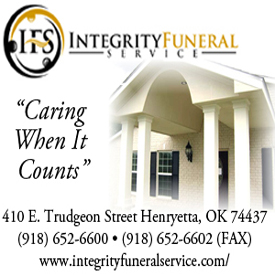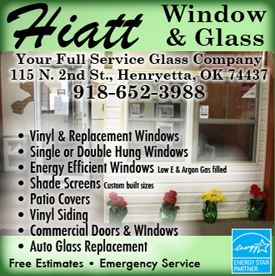By Earl Goldsmith
I don't think Henryetta had Fourth of July fireworks shows before World War II. Still, while I don't recall any fireworks shows, I do recall a few special events at Cameron Field, like the Oklahoma City Girl's Scottish Bagpipe Band and the annual May Day programs.
Okmulgee had what for those days was a big firework show at their Harmon Field football stadium and my family went to them. While waiting for darkness, they had other events.
In 1938, the 4th fell on Monday, so Tulsa's regular Monday night wrestling program was in Okmulgee and I saw world champion Wild Red Barry wrestle. .jpg)
He was from Pittsburg, Kansas, where my family lived from the fall of 1935 until we moved back to Henryetta in the spring of 1938.
I had seen him in a barber shop there when my father was getting a haircut and he said “hi" to little me.
The next year, Okmulgee had a boxing match.
It was the first boxing match I had ever seen, as the 1938 wrestling match also was, and I was amazed that between the rounds, men in each corner were waving towels to cool the boxers.
My mother was from Indiana and had very few relatives in our part of the country, but her Aunt Myrtle and Uncle Jim lived just outside Avant (north of Tulsa). My parents decided we should go visit them in our "new" car on the 4th. We didn't contact them ahead of time, evidently thinking it would be fine to just “drop in."
Actually, while I don't know it to be the case, I doubt if they had a phone, since they lived in a rural area and many still didn't have them then. (We lived in town in Henryetta, but were the only people in our block with a phone until about 1942. My mother didn't mind letting neighbors use our phone, but didn't like the idea of having me run to someone's house to call them to the phone when others called us to talk with them.)
The later fireworks were tame by today's standards, but they were quite the thing back then.
They always had a wheel that made fireworks whirl in a circle and some that glowed in the form of letters to spell words. They had aerial bombs that were puny compared to today's, and the last feature was always an American flag of red, white and blue fireworks, with everyone cheering.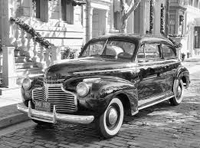 The highway back to Henryetta was always jammed after the end, which I guess confirms my recollection that Henryetta didn't have firework shows.
The highway back to Henryetta was always jammed after the end, which I guess confirms my recollection that Henryetta didn't have firework shows.
The Fourth I remember most was in 1941 when I was eleven. My father had just traded his 1938 Chevrolet for a 1940 model in the spring of 1941 and it was a good thing he did, because when all the auto companies stopped making cars the next February after our entry into WWII, the car nearly everyone had then had to take them through the war.
Back to the 1941 Fourth of July. We left Henryetta very early in the morning and got to their house about 9 a.m. They and their two daughters and son-in-laws were getting ready to have a picnic on Bird Creek, a wide, but usually shallow creek, near Avant. At this point I will point out something that I always thought was strange about their younger daughter. When she was born, Aunt Myrtle and Uncle Jim took a long time to get around to naming her and merely called her Babe, so she went by "Babe" all her life. I think but am not sure, that her birth certificate just showed "Baby" as her name.
There were some huge caves across Bird Creek from the picnic spot and it was easy to wade across to them. The tops of the cave entrances must have been 30 or more feet high, and it was light inside them for quite a distance. A large part of the day for my two sisters (Betty older and Dora younger) was spent exploring the caves and shooting firecrackers in them because the sound reverberation caused much louder bangs there.
Mother had also brought picnic things, so it was quite a day and the picnic was great. There was a lot of food - ham, chicken,, potato salad, baked beans, Aunt Myrtle's daily freshly baked bread, you name it. We also had two or three hand-cranked ice cream machines to make loads ice cream to the delight of we three kids.
Beyond that, we had more pop in a tub of ice than I had ever seen. A lot was strawberry, which I don't think I'd ever had before. Well, I had some that day. I drank eight or more bottles. Aunt Myrtle marveled at how much a boy could drink when I'd had about five bottles, and that just spurred me on. Mother finally stopped me because she didn't want to have a sick kid in the car on the way home.
We left around four and drove to Okmulgee for the fireworks show. I have no specific memories of that particular show except that my father parked at a place where the car nearly turned over into a dropoff place to become our "former" new car, until some men helped him get it out of the place. Then we headed home.
As mentioned earlier, the highway to Henryetta was always jammed after the show, and it was this time, too. Just south of the long ago overpass that was just south of Okmulgee, and near Deep Fork River, there were large drainage ravines on each side of the highway for a short distance. (The Frisco railroad was on the other side of the highway and the area was such that the highway often flooded during the spring rains.)
As we drove through that area, a car pulled out to pass us.
When it passed, we saw it had a rumble seat with a young couple in it.
For those not familiar with that term, a rumble seat was a seat behind the enclosed part of a coupe automobile.
The lid of the trunk had a handle near the coupe interior and when it opened, the lid became the back of a seat while what would normally be the floor of the trunk was the lower part of a seat. Anyone in it was out in the open and outside the actual car.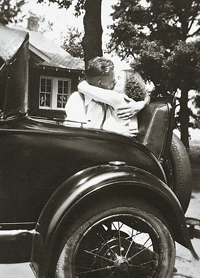 While the car was still passing us, its driver headed on to try to pass the car ahead of us before pulling back into our lane, but suddenly must have realized an oncoming car was so close that he couldn't get back into our lane in time. So he turned left into the ravine of water. The car rolled over as it disappeared from sight.
While the car was still passing us, its driver headed on to try to pass the car ahead of us before pulling back into our lane, but suddenly must have realized an oncoming car was so close that he couldn't get back into our lane in time. So he turned left into the ravine of water. The car rolled over as it disappeared from sight.
My father immediately stopped our car and those behind us stopped too, so nobody got rear-ended. Someone jumped out to flag any northbound cars to stop and men began running into the ravine to render what help they could. Naturally, an “all eyes" eleven year old kid was there to watch.
The couple in the rumble seat had been thrown out as the car rolled, and they were on the bank of the ravine instead of in the water, but they had a lot of bruises.
The couple in the car, which was on its side, was trying to get out of the upper door and some men helped them. They appeared to be hurt more, but they were conscious and walking. My father volunteered to take the couple from the rumble seat back to Okmulgee to the hospital and a man from another car look the other couple. It was crowded in our car, but we made it.
When we got to the hospital, I could see the couple in the light for the first time. The girl had the biggest knot on her forehead that I had ever seen – probably still the biggest knot I've ever seen. The boy had something wrong with a leg, but I don't think anything was broken. I never knew about the condition of the other couple.
We got back in the car and headed toward Henryetta again. By then, most of the traffic from the fireworks show had passed and the highway wasn't nearly as crowded. By the time we got home, it must have been 1 a.m.
It had been quite an eventful day for an 11-year-old boy and his two sisters.
The above account mentions that the auto manufacturers stopped making autos in February 1942. The last ones made were 1942 Chevrolets. All the auto plants started making cannons, tanks, military trucks or cars, etc. for the war. No more cars were made until the fall of 1946 when Ford came out with the first post-war cars The other companies then came out with 1947 models.
They were all rather similar to the 1942 models on which production had been stopped.
When auto production was stopped, the U. S. Government bought the entire stock of new car inventories from the auto manufacturers and dealers and put them in storage around the country so they could be used for things that satisfied what the government agreed was a useful purpose during WWII.
In Henryetta, the government took over a building that had earlier been a bus station at the southwest corner of Third and Trudgeon. It had at least 150 – probably a little more – new cars stored in it. They usually left the building doors open and we could see the cars as we passed by on the way to or from school.
Frequently, the men in charge of the place took them out and drove them around a little, I suppose to keep the batteries charged and make sure they were still operational. They were easy to spot since they were all new and they didn't have license plates. As a kid, I thought Henryetta must be a pretty important place to be selected to store them, but later realized that there were so many to be stored in the whole country, that it couldn't be unusual for a town even some smaller than Henryetta, have some. I still wonder how much heavily rationed gas was in their tanks but suppose it was very little. I have no idea what was done with them or how long it took to remove them after the war. The whole situation was a seldom recalled wartime oddity.
The above also mentions the underpass just south of Okmulgee (by an old Barnsdall [B-Square] refinery. It was an unusual overpass in that it was in effect, a double overpass. Two railroads crossed beneath it one over the other.
The upper railroad was the long-line Frisco (St. Louis, San Francisco, or SLSF), and the lower railroad was the long ago very short-line Okmulgee Northern. I don't recall where the Okmulgee Northern started and ended, but it is possible that it was a short-line road that served Henryetta's old PPG plant and smelter, as well as the Okmulgee Phillips Refinery, to get their products to connect with some other long-line railroad.
A youthful Fourth of July memory
- Details
- Written by Earl Goldsmith









